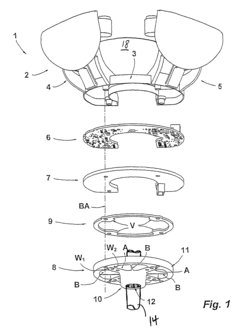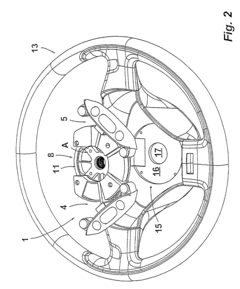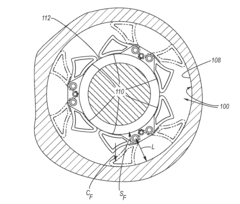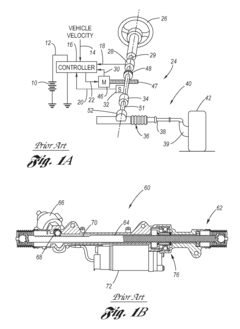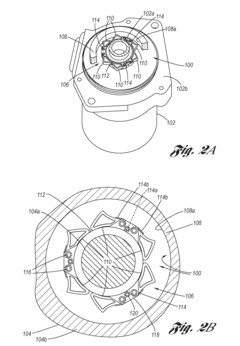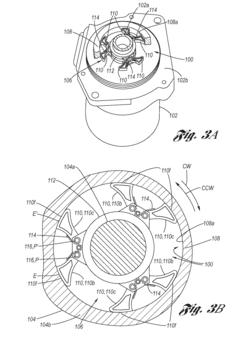How Steering Wheel Innovations Support Electric Powertrains?
JUL 18, 20259 MIN READ
Generate Your Research Report Instantly with AI Agent
Patsnap Eureka helps you evaluate technical feasibility & market potential.
EV Steering Evolution
The evolution of steering systems in electric vehicles (EVs) has been closely intertwined with the development of electric powertrains. As the automotive industry transitions towards electrification, steering wheel innovations have played a crucial role in supporting and enhancing the performance of electric powertrains.
In the early days of EVs, steering systems were largely adapted from traditional internal combustion engine vehicles. However, as electric powertrains became more sophisticated, the need for specialized steering solutions became apparent. The absence of a bulky engine in the front of EVs allowed for greater design flexibility, leading to innovations in steering wheel placement and configuration.
One significant development has been the integration of regenerative braking controls into the steering wheel. This innovation allows drivers to modulate the level of energy recuperation through paddle shifters or touch-sensitive controls on the steering wheel, effectively extending the vehicle's range and improving overall efficiency of the electric powertrain.
The advent of drive-by-wire technology has further revolutionized EV steering systems. By replacing mechanical linkages with electronic controls, these systems offer precise steering input and feedback, complementing the instant torque delivery of electric motors. This synergy between steering and powertrain has resulted in improved vehicle dynamics and driver control.
Another notable evolution has been the introduction of adaptive steering systems in EVs. These systems can adjust steering ratios and effort based on vehicle speed, driving mode, and road conditions. This adaptability not only enhances the driving experience but also optimizes energy consumption by reducing unnecessary steering inputs and minimizing tire wear.
The trend towards autonomous driving capabilities in EVs has also influenced steering wheel design. Retractable or foldaway steering wheels have been developed to accommodate self-driving modes, allowing for more flexible interior layouts when manual control is not required. These innovations reflect the changing role of the steering wheel in an increasingly electrified and automated automotive landscape.
Furthermore, the integration of advanced driver assistance systems (ADAS) into steering wheels has become more prevalent in EVs. Features such as lane-keeping assist, adaptive cruise control, and collision avoidance systems are now often controlled through the steering wheel, creating a seamless interface between the driver, the vehicle's electric powertrain, and its safety systems.
As EVs continue to evolve, steering wheel innovations are expected to play an even more significant role in supporting electric powertrains. Future developments may include haptic feedback systems that provide drivers with real-time information about vehicle performance and energy consumption, further optimizing the efficiency of electric powertrains through intuitive driver interactions.
In the early days of EVs, steering systems were largely adapted from traditional internal combustion engine vehicles. However, as electric powertrains became more sophisticated, the need for specialized steering solutions became apparent. The absence of a bulky engine in the front of EVs allowed for greater design flexibility, leading to innovations in steering wheel placement and configuration.
One significant development has been the integration of regenerative braking controls into the steering wheel. This innovation allows drivers to modulate the level of energy recuperation through paddle shifters or touch-sensitive controls on the steering wheel, effectively extending the vehicle's range and improving overall efficiency of the electric powertrain.
The advent of drive-by-wire technology has further revolutionized EV steering systems. By replacing mechanical linkages with electronic controls, these systems offer precise steering input and feedback, complementing the instant torque delivery of electric motors. This synergy between steering and powertrain has resulted in improved vehicle dynamics and driver control.
Another notable evolution has been the introduction of adaptive steering systems in EVs. These systems can adjust steering ratios and effort based on vehicle speed, driving mode, and road conditions. This adaptability not only enhances the driving experience but also optimizes energy consumption by reducing unnecessary steering inputs and minimizing tire wear.
The trend towards autonomous driving capabilities in EVs has also influenced steering wheel design. Retractable or foldaway steering wheels have been developed to accommodate self-driving modes, allowing for more flexible interior layouts when manual control is not required. These innovations reflect the changing role of the steering wheel in an increasingly electrified and automated automotive landscape.
Furthermore, the integration of advanced driver assistance systems (ADAS) into steering wheels has become more prevalent in EVs. Features such as lane-keeping assist, adaptive cruise control, and collision avoidance systems are now often controlled through the steering wheel, creating a seamless interface between the driver, the vehicle's electric powertrain, and its safety systems.
As EVs continue to evolve, steering wheel innovations are expected to play an even more significant role in supporting electric powertrains. Future developments may include haptic feedback systems that provide drivers with real-time information about vehicle performance and energy consumption, further optimizing the efficiency of electric powertrains through intuitive driver interactions.
Market Demand Analysis
The market demand for steering wheel innovations that support electric powertrains is experiencing significant growth, driven by the rapid expansion of the electric vehicle (EV) sector. As automakers transition towards electrification, there is an increasing need for steering systems that complement the unique characteristics of electric powertrains.
One of the primary drivers of this demand is the pursuit of energy efficiency in EVs. Traditional hydraulic power steering systems are energy-intensive and can reduce the overall range of electric vehicles. Consequently, there is a strong market pull for electric power steering (EPS) systems that are more energy-efficient and can help extend the driving range of EVs.
The integration of advanced driver assistance systems (ADAS) and autonomous driving features in electric vehicles is another factor fueling the demand for innovative steering wheel solutions. These technologies require steering systems that can interface seamlessly with electronic control units and provide precise, responsive steering control.
Furthermore, the shift towards electric powertrains has opened up new possibilities for vehicle interior design. This has created a market for steering wheel innovations that can accommodate new functionalities and improve the overall driving experience. For instance, there is growing interest in steer-by-wire systems that allow for more flexible placement of the steering wheel or even its removal in fully autonomous modes.
The market is also seeing increased demand for steering wheels with integrated haptic feedback and touch-sensitive controls. These features align well with the high-tech image of electric vehicles and can provide drivers with intuitive access to various vehicle functions without taking their hands off the wheel.
Another emerging trend is the demand for lightweight steering components that can contribute to overall vehicle weight reduction, thereby improving the energy efficiency and range of electric vehicles. This has led to a market for steering wheels and columns made from advanced materials such as carbon fiber composites.
The global nature of the automotive industry means that these market demands are not limited to specific regions. However, markets with strong EV adoption rates, such as China, Europe, and North America, are likely to see the highest demand for these steering wheel innovations.
In terms of market size, the global automotive steering system market is projected to grow significantly in the coming years, with electric power steering systems expected to capture a large share of this growth. This trend is closely tied to the expanding electric vehicle market, which is forecasted to continue its rapid growth trajectory.
One of the primary drivers of this demand is the pursuit of energy efficiency in EVs. Traditional hydraulic power steering systems are energy-intensive and can reduce the overall range of electric vehicles. Consequently, there is a strong market pull for electric power steering (EPS) systems that are more energy-efficient and can help extend the driving range of EVs.
The integration of advanced driver assistance systems (ADAS) and autonomous driving features in electric vehicles is another factor fueling the demand for innovative steering wheel solutions. These technologies require steering systems that can interface seamlessly with electronic control units and provide precise, responsive steering control.
Furthermore, the shift towards electric powertrains has opened up new possibilities for vehicle interior design. This has created a market for steering wheel innovations that can accommodate new functionalities and improve the overall driving experience. For instance, there is growing interest in steer-by-wire systems that allow for more flexible placement of the steering wheel or even its removal in fully autonomous modes.
The market is also seeing increased demand for steering wheels with integrated haptic feedback and touch-sensitive controls. These features align well with the high-tech image of electric vehicles and can provide drivers with intuitive access to various vehicle functions without taking their hands off the wheel.
Another emerging trend is the demand for lightweight steering components that can contribute to overall vehicle weight reduction, thereby improving the energy efficiency and range of electric vehicles. This has led to a market for steering wheels and columns made from advanced materials such as carbon fiber composites.
The global nature of the automotive industry means that these market demands are not limited to specific regions. However, markets with strong EV adoption rates, such as China, Europe, and North America, are likely to see the highest demand for these steering wheel innovations.
In terms of market size, the global automotive steering system market is projected to grow significantly in the coming years, with electric power steering systems expected to capture a large share of this growth. This trend is closely tied to the expanding electric vehicle market, which is forecasted to continue its rapid growth trajectory.
Current Challenges
The integration of steering wheel innovations with electric powertrains presents several significant challenges that require careful consideration and innovative solutions. One of the primary obstacles is the need to seamlessly incorporate advanced driver assistance systems (ADAS) and autonomous driving technologies into the steering system while maintaining the traditional feel and functionality of the steering wheel.
Electric powertrains offer unique opportunities for by-wire steering systems, which can potentially eliminate the need for mechanical linkages between the steering wheel and the wheels. However, this transition raises concerns about system reliability, fail-safe mechanisms, and the ability to provide accurate haptic feedback to the driver. Ensuring a consistent and natural steering feel in the absence of traditional mechanical connections is a complex engineering challenge.
Another critical issue is the integration of regenerative braking controls into the steering wheel. As electric vehicles rely heavily on regenerative braking to maximize efficiency and range, finding intuitive ways to control this feature through the steering wheel without compromising safety or driver comfort is crucial. This challenge is compounded by the need to balance regenerative braking with traditional friction braking systems.
The weight and packaging constraints of electric vehicles also pose challenges for steering wheel design. With the need to maximize interior space and minimize overall vehicle weight to extend range, steering systems must become more compact and lightweight without sacrificing performance or safety. This includes the integration of various controls and displays into the steering wheel while maintaining a clean, ergonomic design.
Power management is another significant challenge. Electric powertrains require careful energy allocation, and the steering system must be designed to operate efficiently within these constraints. This includes developing low-power steering assist systems that can provide adequate support without significantly impacting the vehicle's range.
Furthermore, the rapid evolution of electric vehicle technology necessitates a flexible and adaptable steering wheel design. Future-proofing steering systems to accommodate upcoming technologies, such as advanced human-machine interfaces, biometric sensors, or even shape-shifting capabilities, is a complex task that requires foresight and innovative engineering approaches.
Lastly, regulatory compliance and safety standards present ongoing challenges. As regulations evolve to address the unique characteristics of electric vehicles and autonomous driving technologies, steering wheel designs must adapt to meet these new requirements while still providing an intuitive and engaging driving experience.
Electric powertrains offer unique opportunities for by-wire steering systems, which can potentially eliminate the need for mechanical linkages between the steering wheel and the wheels. However, this transition raises concerns about system reliability, fail-safe mechanisms, and the ability to provide accurate haptic feedback to the driver. Ensuring a consistent and natural steering feel in the absence of traditional mechanical connections is a complex engineering challenge.
Another critical issue is the integration of regenerative braking controls into the steering wheel. As electric vehicles rely heavily on regenerative braking to maximize efficiency and range, finding intuitive ways to control this feature through the steering wheel without compromising safety or driver comfort is crucial. This challenge is compounded by the need to balance regenerative braking with traditional friction braking systems.
The weight and packaging constraints of electric vehicles also pose challenges for steering wheel design. With the need to maximize interior space and minimize overall vehicle weight to extend range, steering systems must become more compact and lightweight without sacrificing performance or safety. This includes the integration of various controls and displays into the steering wheel while maintaining a clean, ergonomic design.
Power management is another significant challenge. Electric powertrains require careful energy allocation, and the steering system must be designed to operate efficiently within these constraints. This includes developing low-power steering assist systems that can provide adequate support without significantly impacting the vehicle's range.
Furthermore, the rapid evolution of electric vehicle technology necessitates a flexible and adaptable steering wheel design. Future-proofing steering systems to accommodate upcoming technologies, such as advanced human-machine interfaces, biometric sensors, or even shape-shifting capabilities, is a complex task that requires foresight and innovative engineering approaches.
Lastly, regulatory compliance and safety standards present ongoing challenges. As regulations evolve to address the unique characteristics of electric vehicles and autonomous driving technologies, steering wheel designs must adapt to meet these new requirements while still providing an intuitive and engaging driving experience.
Existing EV Solutions
01 Adjustable steering wheel support systems
These systems allow for the adjustment of the steering wheel position to accommodate different drivers. They may include mechanisms for tilting, telescoping, or height adjustment of the steering column, enhancing driver comfort and ergonomics.- Adjustable steering wheel support systems: These systems allow for the adjustment of the steering wheel position to accommodate different drivers and improve ergonomics. They may include mechanisms for tilting, telescoping, or height adjustment of the steering column, enhancing driver comfort and control.
- Steering wheel support for disabled drivers: Specialized support systems designed to assist drivers with disabilities in operating vehicles. These may include adaptive controls, hand-operated devices, or modified steering wheel grips to enable safe and comfortable driving for individuals with limited mobility or strength.
- Steering wheel support for gaming and simulation: Support systems designed for use in gaming setups or vehicle simulators. These supports provide a stable platform for mounting steering wheels used in racing games or training simulations, often with adjustable features to enhance realism and user experience.
- Collapsible steering wheel support for safety: Safety-oriented support systems that allow the steering wheel to collapse or deform in the event of a collision. These designs aim to reduce the risk of injury to the driver by absorbing impact energy and preventing the steering column from intruding into the cabin.
- Steering wheel support with integrated controls: Advanced support systems that incorporate additional vehicle controls into the steering wheel or its immediate vicinity. These may include buttons, switches, or touch-sensitive surfaces for controlling various vehicle functions without removing hands from the wheel, improving safety and convenience.
02 Steering wheel support for disabled drivers
Specialized support systems designed to assist drivers with disabilities. These may include additional hand controls, modified steering mechanisms, or support structures to enable safe and comfortable driving for individuals with limited mobility or strength.Expand Specific Solutions03 Steering wheel support in autonomous vehicles
Support systems designed for steering wheels in autonomous or semi-autonomous vehicles. These may include retractable or stowable steering wheels, or support structures that allow for easy transition between manual and autonomous driving modes.Expand Specific Solutions04 Vibration dampening steering wheel supports
Support systems that incorporate vibration dampening technologies to reduce driver fatigue and improve vehicle handling. These may use various materials or mechanical designs to absorb and dissipate vibrations from the road and engine.Expand Specific Solutions05 Steering wheel support for racing or high-performance vehicles
Specialized support systems designed for racing or high-performance vehicles. These may include quick-release mechanisms, reinforced structures to withstand high forces, or ergonomic designs for optimal driver control during high-speed maneuvers.Expand Specific Solutions
Key Industry Players
The steering wheel innovation landscape for electric powertrains is in a dynamic growth phase, with a rapidly expanding market driven by the shift towards electrification in the automotive industry. The technology is maturing, but still evolving as major players invest in research and development. Companies like Ford Global Technologies, GM Global Technology Operations, and Robert Bosch GmbH are at the forefront, leveraging their extensive automotive expertise to develop advanced steering solutions. Emerging players such as NSK Steering Systems and Schaeffler Technologies are also making significant contributions, focusing on specialized steering technologies for electric vehicles. The competitive landscape is characterized by a mix of established automotive giants and innovative suppliers, all vying to capture market share in this growing segment.
Robert Bosch GmbH
Technical Solution: Bosch has developed an innovative steer-by-wire system specifically designed for electric vehicles. This system replaces the mechanical connection between the steering wheel and wheels with electronic controls and actuators. It allows for variable steering ratios and customizable steering feel, which can be adjusted based on driving conditions or driver preferences[1]. The system also integrates with other vehicle systems, such as advanced driver assistance features and autonomous driving capabilities, making it well-suited for the evolving needs of electric and autonomous vehicles[2]. Additionally, Bosch's steer-by-wire technology enables the implementation of fail-operational architectures, enhancing safety in electric vehicles[3].
Strengths: Highly customizable, integrates well with autonomous systems, improves safety. Weaknesses: Requires sophisticated electronic systems, potentially higher initial cost, may face regulatory challenges in some markets.
DENSO Corp.
Technical Solution: DENSO has developed a compact, high-output electric power steering (EPS) system tailored for electric vehicles. This system utilizes advanced motor and control technologies to provide precise steering assistance while minimizing power consumption. DENSO's EPS incorporates a high-efficiency electric motor and a sophisticated electronic control unit that can adapt to various driving conditions[4]. The system also features a regenerative function that can recover energy during steering operations, contributing to overall vehicle efficiency[5]. Furthermore, DENSO's EPS is designed to be lightweight and compact, which aligns with the space and weight constraints often present in electric vehicle designs[6].
Strengths: Energy-efficient, compact design, contributes to overall vehicle efficiency. Weaknesses: May require frequent software updates, potential for electromagnetic interference with other vehicle systems.
Core Steering Patents
Steering wheel for a motor vehicle
PatentInactiveUS7950690B2
Innovation
- The steering wheel module integrates a torsion module that allows the steering wheel to be assembled and tested as a whole, including torque detection, before being attached to the steering spindle, enabling pre-assembly functionality testing and simplifying the assembly process by attaching the module to the steering wheel via the torsion module.
Electric power steering system over-speed energizing brake system
PatentInactiveUS8177018B2
Innovation
- A bi-directional over-speed energizing brake system automatically engages to reduce rotational inertia by using a brake ring and pivotally connected brake arms biased by springs, which are disengaged at normal speeds but engage due to centrifugal force when rotational speeds exceed a threshold, applying braking torque to prevent component damage.
Energy Efficiency Impact
Steering wheel innovations in electric vehicles play a crucial role in enhancing energy efficiency, contributing significantly to the overall performance and range of electric powertrains. These advancements focus on optimizing the interaction between the driver and the vehicle's systems, resulting in more efficient energy utilization.
One of the key areas where steering wheel innovations impact energy efficiency is through improved regenerative braking control. Advanced steering wheels now incorporate paddle shifters or touch-sensitive surfaces that allow drivers to adjust regenerative braking levels on the fly. This feature enables more precise control over energy recuperation, maximizing the amount of kinetic energy converted back into electrical energy during deceleration and braking.
Furthermore, steering wheel innovations have led to the integration of intelligent energy management systems. These systems use sensors and algorithms to analyze driving patterns and road conditions, adjusting power delivery and regenerative braking accordingly. By providing real-time feedback through the steering wheel's display or haptic signals, drivers can make more informed decisions about their driving style, leading to improved energy conservation.
The introduction of steer-by-wire technology in electric vehicles has also contributed to energy efficiency. This system eliminates the mechanical connection between the steering wheel and the wheels, replacing it with electronic controls. As a result, the power steering system can be optimized for electric powertrains, reducing energy consumption compared to traditional hydraulic systems.
Steering wheel innovations have also focused on weight reduction and the use of sustainable materials. Lightweight designs and the incorporation of recycled or bio-based materials not only reduce the overall vehicle weight but also contribute to improved energy efficiency by decreasing the power required to move the vehicle.
Additionally, advanced steering wheels now feature integrated driver monitoring systems. These systems use cameras and sensors to detect driver fatigue, distraction, or inefficient driving behaviors. By providing timely alerts and suggestions through the steering wheel interface, these innovations help maintain optimal driving efficiency, further supporting the electric powertrain's energy management.
In conclusion, steering wheel innovations have a multifaceted impact on the energy efficiency of electric powertrains. From enhanced regenerative braking control to intelligent energy management systems and lightweight designs, these advancements play a crucial role in maximizing the range and performance of electric vehicles while minimizing energy consumption.
One of the key areas where steering wheel innovations impact energy efficiency is through improved regenerative braking control. Advanced steering wheels now incorporate paddle shifters or touch-sensitive surfaces that allow drivers to adjust regenerative braking levels on the fly. This feature enables more precise control over energy recuperation, maximizing the amount of kinetic energy converted back into electrical energy during deceleration and braking.
Furthermore, steering wheel innovations have led to the integration of intelligent energy management systems. These systems use sensors and algorithms to analyze driving patterns and road conditions, adjusting power delivery and regenerative braking accordingly. By providing real-time feedback through the steering wheel's display or haptic signals, drivers can make more informed decisions about their driving style, leading to improved energy conservation.
The introduction of steer-by-wire technology in electric vehicles has also contributed to energy efficiency. This system eliminates the mechanical connection between the steering wheel and the wheels, replacing it with electronic controls. As a result, the power steering system can be optimized for electric powertrains, reducing energy consumption compared to traditional hydraulic systems.
Steering wheel innovations have also focused on weight reduction and the use of sustainable materials. Lightweight designs and the incorporation of recycled or bio-based materials not only reduce the overall vehicle weight but also contribute to improved energy efficiency by decreasing the power required to move the vehicle.
Additionally, advanced steering wheels now feature integrated driver monitoring systems. These systems use cameras and sensors to detect driver fatigue, distraction, or inefficient driving behaviors. By providing timely alerts and suggestions through the steering wheel interface, these innovations help maintain optimal driving efficiency, further supporting the electric powertrain's energy management.
In conclusion, steering wheel innovations have a multifaceted impact on the energy efficiency of electric powertrains. From enhanced regenerative braking control to intelligent energy management systems and lightweight designs, these advancements play a crucial role in maximizing the range and performance of electric vehicles while minimizing energy consumption.
Safety Considerations
Safety considerations play a crucial role in the development and implementation of steering wheel innovations for electric powertrains. As the automotive industry transitions towards electrification, the integration of advanced steering systems with electric powertrains presents unique challenges and opportunities for enhancing vehicle safety.
One of the primary safety considerations is the management of electromagnetic interference (EMI) between the electric powertrain and the steering system. Electric motors and power electronics in electric vehicles generate significant electromagnetic fields, which can potentially interfere with the sensitive electronic components of modern steering systems. To address this issue, manufacturers are developing advanced shielding techniques and implementing robust EMI mitigation strategies to ensure the reliable operation of steering systems in electric vehicles.
The regenerative braking capabilities of electric powertrains also introduce new safety considerations for steering wheel design. As regenerative braking systems can provide significant deceleration without engaging the traditional friction brakes, steering wheel innovations must account for the altered feel and feedback during braking events. This includes developing adaptive steering assistance systems that can adjust to the varying levels of vehicle deceleration and maintain consistent steering feel across different driving scenarios.
Another important safety aspect is the integration of advanced driver assistance systems (ADAS) with steering wheel innovations in electric vehicles. As ADAS features become more prevalent, steering wheels are evolving to incorporate sensors and controls that facilitate seamless interaction between the driver and these safety systems. This includes the development of capacitive touch sensors, haptic feedback mechanisms, and integrated displays that can provide critical safety information and alerts to the driver without compromising steering control.
The potential for increased automation in electric vehicles also influences steering wheel safety considerations. As vehicles progress towards higher levels of autonomy, steering wheel innovations must address the transition between manual and automated driving modes. This includes developing systems that can safely disengage and re-engage driver control, as well as providing clear indications of the vehicle's current operational mode to prevent confusion and ensure driver readiness.
Weight reduction is another key consideration in electric vehicle design, and steering wheel innovations must balance safety requirements with the need for lightweight components. This has led to the exploration of new materials and construction techniques that can maintain or enhance safety performance while reducing overall mass. Advanced composites and innovative structural designs are being employed to create steering wheels that are both lightweight and capable of meeting stringent safety standards.
Lastly, the unique characteristics of electric powertrains, such as instant torque delivery and precise motor control, present opportunities for enhancing vehicle stability and safety through steering innovations. Manufacturers are developing advanced torque vectoring systems that can work in conjunction with electric motors to improve vehicle handling and stability, particularly in emergency maneuvers or adverse weather conditions. These systems often rely on sophisticated steering control algorithms that can rapidly adjust steering response based on real-time vehicle dynamics data.
One of the primary safety considerations is the management of electromagnetic interference (EMI) between the electric powertrain and the steering system. Electric motors and power electronics in electric vehicles generate significant electromagnetic fields, which can potentially interfere with the sensitive electronic components of modern steering systems. To address this issue, manufacturers are developing advanced shielding techniques and implementing robust EMI mitigation strategies to ensure the reliable operation of steering systems in electric vehicles.
The regenerative braking capabilities of electric powertrains also introduce new safety considerations for steering wheel design. As regenerative braking systems can provide significant deceleration without engaging the traditional friction brakes, steering wheel innovations must account for the altered feel and feedback during braking events. This includes developing adaptive steering assistance systems that can adjust to the varying levels of vehicle deceleration and maintain consistent steering feel across different driving scenarios.
Another important safety aspect is the integration of advanced driver assistance systems (ADAS) with steering wheel innovations in electric vehicles. As ADAS features become more prevalent, steering wheels are evolving to incorporate sensors and controls that facilitate seamless interaction between the driver and these safety systems. This includes the development of capacitive touch sensors, haptic feedback mechanisms, and integrated displays that can provide critical safety information and alerts to the driver without compromising steering control.
The potential for increased automation in electric vehicles also influences steering wheel safety considerations. As vehicles progress towards higher levels of autonomy, steering wheel innovations must address the transition between manual and automated driving modes. This includes developing systems that can safely disengage and re-engage driver control, as well as providing clear indications of the vehicle's current operational mode to prevent confusion and ensure driver readiness.
Weight reduction is another key consideration in electric vehicle design, and steering wheel innovations must balance safety requirements with the need for lightweight components. This has led to the exploration of new materials and construction techniques that can maintain or enhance safety performance while reducing overall mass. Advanced composites and innovative structural designs are being employed to create steering wheels that are both lightweight and capable of meeting stringent safety standards.
Lastly, the unique characteristics of electric powertrains, such as instant torque delivery and precise motor control, present opportunities for enhancing vehicle stability and safety through steering innovations. Manufacturers are developing advanced torque vectoring systems that can work in conjunction with electric motors to improve vehicle handling and stability, particularly in emergency maneuvers or adverse weather conditions. These systems often rely on sophisticated steering control algorithms that can rapidly adjust steering response based on real-time vehicle dynamics data.
Unlock deeper insights with Patsnap Eureka Quick Research — get a full tech report to explore trends and direct your research. Try now!
Generate Your Research Report Instantly with AI Agent
Supercharge your innovation with Patsnap Eureka AI Agent Platform!

